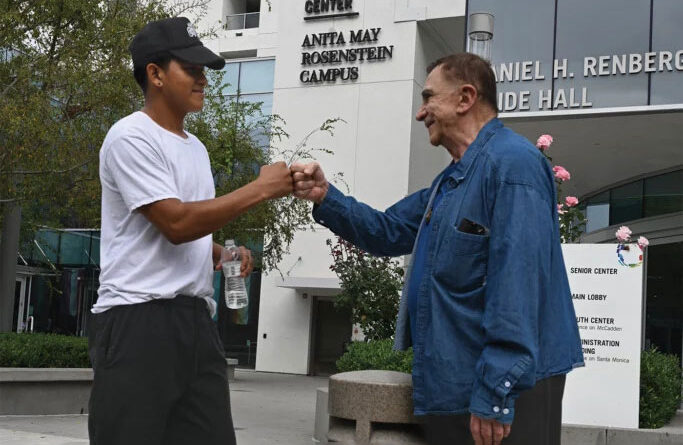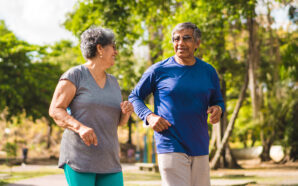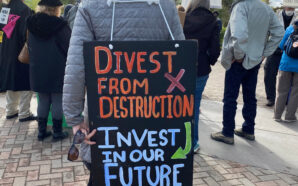When Lisa Chilton, 65, leaves her studio apartment, she often encounters several young people hanging out near the entrance of the five-story senior housing complex she has called home since 2021. Because Chilton knows most of her young acquaintances’ faces but not all of their names, she’s nicknamed them. There’s the 19-year-old whom she has secretly named “Angry Boy,” and the young teen whom Chilton refers to as “Pretty Girl With Glasses.” And most days, there is the tall transgender youth who likes to talk to Chilton about her hair.
Chilton’s apartment building is located within the Los Angeles LGBT Center’s Anita May Rosenstein campus, which is designed to facilitate intergenerational interaction. The bustling 180,000-square-foot Rosenstein campus brings LGBTQ youth, seniors, and housing together in a unified setting. It opened in 2019 to much fanfare and is the only large-scale intergenerational campus in the United States to specifically provide housing, services, and programs for LGBTQ adults aged 50 and older with low incomes, and for LGBTQ youth—primarily aged 18 to 24—experiencing homelessness.
“I look after them and they look after us,” says Chilton, who is a lesbian. “I live in a colorful building in a colorful neighborhood. We have every race, we have everyone across the sexual and gender continuum. It’s almost a microcosm of the world.”
The Campus also serves as the administrative headquarters for the 54-year-old Center, which is the largest LGBTQ organization in the world, with seven locations across the city. “Some of our seniors feel very isolated, and being able to interface with the youth, I think that’s pretty special,” explains Lisa Phillips, the Center’s director of youth services. “We had an intergenerational Thanksgiving event last year, and it was a line out the door. The seniors had a great time; the youth had a great time.”
In March, the Center hosted an opportunity fair for youth and seniors looking for employment; youth residents later performed a drag show during a senior dance hosted at the Ariadne Getty Foundation Senior Housing complex. Kiera Pollock, the Center’s director of senior services, says these facilitated intergenerational interactions help create intentional opportunities for connection between people who may be at vastly different points in their lives. “Our folks have different challenges in the community, and we have to kind of meet them where they are,” Pollock says. “I think many of our youth are trying to just figure out … how to survive, how to get back into school, how to stabilize their lives, how to get clean. So the way in which they interact with the older adults, we found, has to be kind of structured within a program that makes the most sense.”
On any given day, there are more than 4,000 youths (under age 24) living on the streets of Los Angeles, mostly in Hollywood, according to the Los Angeles Homeless Services Authority 2020 count. The percentage of unhoused youth who are LGBTQ can be as high as 40%, according to the Center. Before senior housing was available on the Rosenstein campus, the Center opened the doors of the Michaeljohn Horne & Thomas Eugene Jones Youth Housing building in 2021. The 25 apartments in the building are the first micro-units designed for LGBTQ youth experiencing homelessness in Los Angeles, according to the Center.
The campus also offers 92 beds available for youths—52 for the Transitional Living Project (TLP), where youths can stay for up to 24 months. Youths housed in the TLP work with Center staff to develop the skills they need to be able to live independently. The remaining 40 beds are for an emergency and crisis shelter. Youth residents have access to the Center’s full range of wraparound services and support, including case management, education, employment training and placement, health and mental health care, food and clothing assistance, counseling and support groups, and activities and events.
Carlos J. Mejia Vijil, 23, moved out of TLP in July, after living there for two years. He first arrived at the Center when he was just 19, after making a harrowing journey through Mexico from Honduras, where he feared for his life because he is gay. An immigrant-rights attorney connected him with the Center’s legal services department, which represents immigration and asylum clients from more than 70 countries—many of whom risk arrest or physical harm if they go back to their home countries because they are LGBTQ. “They helped me out with everything,” Mejia Vijil says of Center staff. “Everything I have, every opportunity is thanks to the Center.”
Mejia Vijil was initially placed in the Center’s emergency overnight shelter, then moved into TLP. He made the most of his opportunities by completing an English as a second language program held at nearby Hollywood High School, then enrolled in the culinary arts program on campus. “The culinary classes are in English, and I was just learning English. I tried real hard,” he says. “The older people were co-workers, and we talked like friends. They really respected who I am.” Mejia Vijil now works as a line cook at Osteria La Buca on trendy Melrose Avenue, and lives in his own apartment in Hollywood.
Connecting Across Age
The Center’s culinary arts and social services training programs are the most prominent examples of success in forging intergenerational connections in the classroom. The 100-hour social services vocational training program teaches younger and older students necessary skills to build a career in social services. Many graduates have since landed jobs at the Center, working in intake, street outreach, and peer support.
The 12-week, 300-hour culinary program focuses on developing basic culinary skills, producing 500 meals a day to be served to Center clients. Students also do a four-week internship at a local restaurant or hotel, and are then offered job placement assistance within the restaurant or hospitality sector. “I think what’s been pretty amazing [is] to be able to have youth and seniors enrolled in a culinary class together,” Phillips says. “Many of these young people have not had adults who are affirming of their identity. To see the seniors and a generation of older queer people, and to be able to support them and to share their experience from a different generation, has been really remarkable.”
Pollock says since the older students usually have career and employment experience, mentoring and an abundance of mutual support occur organically in the campus’s commercial kitchen, where classes and meal production take place. And despite the decades between them, the students’ experiences sometimes mirror each other when it comes to gender identity or sexual orientation.
“We had in our culinary program a youth who was transitioning and a senior who was transitioning,” Pollock recalls. “They just happen to both apply for the program at the same time. They were able to support each other and talk about some of the different issues around that together—how they were dressing and using different pronouns. And they talked together about how that transition is different for a younger person. That was amazing to watch.”
After a career in sales, 64-year-old Annetta Daniel, who is gay, hopes to work with food in a variety of ways, and so jumped at the opportunity to enroll in the culinary program. “They make you very aware that this is going to be the seniors and the youth mixed. I thought, that’s fantastic!” Daniel says. “I know I have a lot to bring to the table for them. I’ve been down the road that they’re headed down. And they’re going to bring a lot to the table for me.”
When Daniel first moved into the Getty building in 2021, “I had nothing but my clothes,” she says. Her partner of 23 years had died in 2017, leading to housing instability. She was diagnosed with breast cancer, which enabled her to secure temporary housing because she was high-risk due to her health, then she moved into her current home in the Getty building, where she has thrived. “I want to grow as tall as I can, I want to know as much as I can, and I want to go as many places as I can,” Daniel says. “I want to have as many friends as I can, and experiences, and this place offers that to me.”
The High Demand for Housing
The Center has a total of 202 units of affordable housing for seniors who are 62 or older. More than half of the units are in the Triangle Square Senior Apartments complex, located at the corner of Selma and Ivar in Hollywood—one mile away from the main campus. Of the estimated 65,000 LGBTQ seniors who call Los Angeles home, a majority (68%) live alone, as LGBTQ seniors nationwide are four times less likely to have children or grandchildren to care for them than their heterosexual counterparts, and are twice as likely to be single, notes Pollock.
Before the doors of the Center’s affordable senior housing units had even opened in late summer 2021, more than 2,000 applications had been submitted. Most of the residents were chosen by a lottery system, but 25 of the units are designated as permanent supportive housing units for seniors experiencing homelessness, whose rents are funded by L.A. county and city grants.
The Triangle Square complex has an outdoor swimming pool and garden while the Getty building has amenities including a community room, communal kitchen, pool table, and a fitness center. Residents have direct access to the Center’s Harry and Jeanette Weinberg Senior Center and its services that include counseling and support groups, case management, home-delivered meals, in-home care, and benefits assistance. Residents can also be connected to health and mental health care, and HIV support.
For Chilton, moving into the building has been “life-changing.” “It is a personal miracle,” she says. “It’s about having my own sanctuary. You don’t really understand that until you don’t have one. I had 10 years without [my] own sanctuary, of couch surfing and trying to make myself small, to not get in the way. Everything in my life has fallen into place, with a constant state of contentment. I don’t know that I ever felt this good emotionally, spiritually, and physically.”
John Maragioglio, an 82-year-old Air Force veteran, has also found community since moving into the Getty building in October 2021. He worked at the Center as an accountant in the 1980s, during the worst days of the AIDS epidemic, and returned to the Center in 2021 when he needed a place to live. “I’ve met a lot of gay people in here,” says Maragioglio, who is also gay and attends a veterans social group every Wednesday. “There’s one guy who does a movie night twice a month downstairs. You go to lunch downstairs every day. It’s so nice to have that lunch.”
He has not connected with the youth the way Chilton and others have, but he’s usually happy to see them around. “I can see where some of them have a little attitude,” he says. “But you know, we have to realize all kids have attitudes. They’re just finding themselves.”
Together, Independently
Center leadership has been learning in real time how to best bring the seniors and youth together. Pollock says they’ve had to learn to manage their expectations and be mindful that youth who have recently experienced homelessness may also have suffered any number of traumas in their young lifetimes.
“I think their goals are different in intergenerational connection, and we had to learn that right away,” she says of the youth. “It’s really great that folks get to connect across our programs but can still go back home to live in their units, where maybe they’re hanging out with other 21-year-olds. Our [senior] folks are hanging out with other 70-year-olds, who maybe want it quiet after 9 p.m.”
But when the connections are made, they can be invaluable. “In the LGBT community, often people come out but they don’t have any members of their family who are queer,” Pollock says. “As a younger person, you don’t necessarily have another gay person in your direct life to mentor you. So the opportunity for some of our seniors to kind of mentor and support our youth, it’s really powerful in a community that doesn’t have that.”
Greg Hernandez wrote this article for Yes! Magazine.






